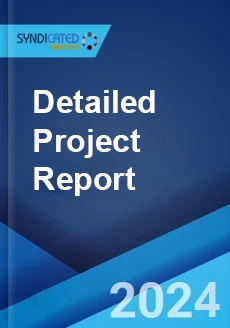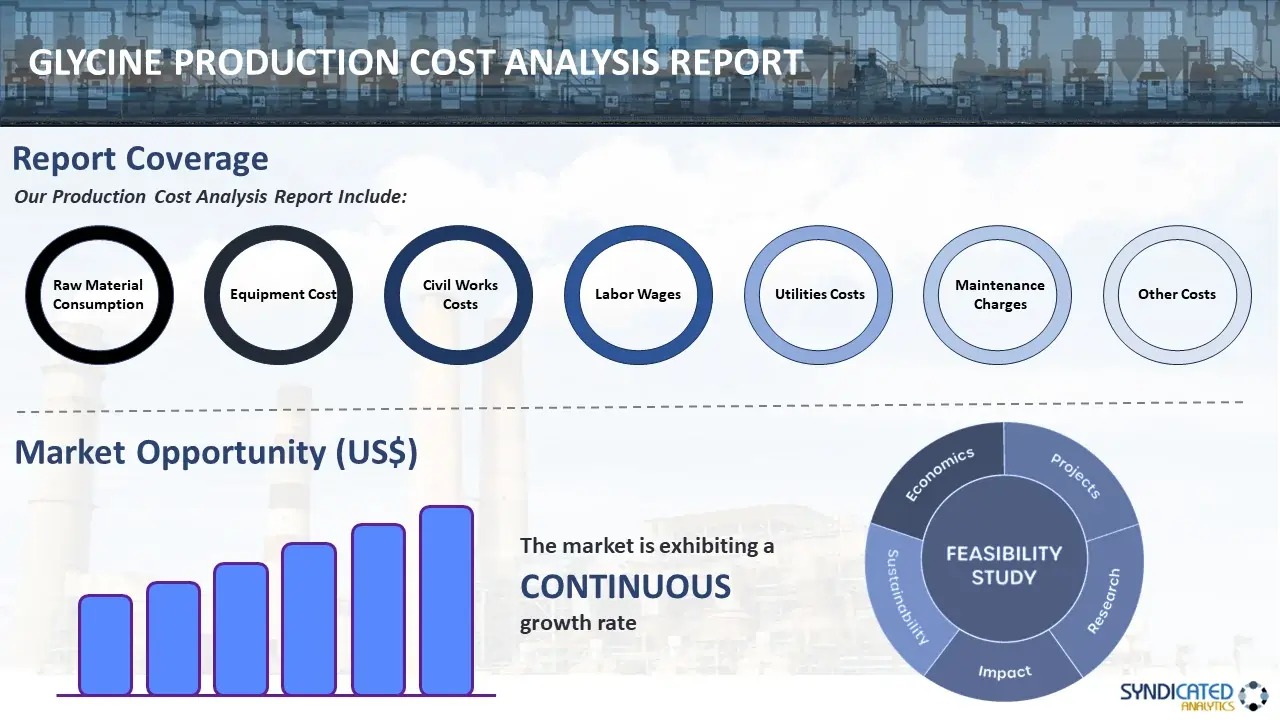
Glycine Production Cost Analysis Report 2025 Edition: Industry Trends, Capital Investment, Price Trends, Manufacturing Process, Raw Materials Requirement, Operating Cost, and Revenue Statistics
Report Overview:
The report by Syndicated Analytics, titled “Glycine Production Cost Analysis Report 2025 Edition: Industry Trends, Capital Investment, Price Trends, Manufacturing Process, Raw Materials Requirement, Operating Cost, and Revenue Statistics,” offers a comprehensive examination of the operating costs and revenue statistics associated with establishing a glycine plant. It is the culmination of extensive primary and secondary research, encompassing a detailed analysis of market trends and the impact of COVID-19 on both global and regional levels. Additionally, it provides profiles of key industry players. The report also delves into price trends, mass balance required raw materials, and the various unit operations integral to the glycine manufacturing process. It includes a comprehensive capital cost analysis while covering the cost breakdown of raw materials, utilities, labor, packaging, transportation, land and construction, and machinery. The study also presents projected profit margins and recommends optimal product pricing strategies. For individuals contemplating entry into the glycine industry or those with vested interests, this report is an essential resource.

Glycine (CHNO) is a non-optical, non-polar, glucogenic amino acid that is naturally found in several protein-rich foods, such as fish, dairy, legumes, and meat. It is colorless, water-soluble, has a sweet taste, and is widely used in the pharmaceutical industry. Glycine is produced from serine, choline, hydroxyproline, and threonine using interorgan metabolism where kidneys and liver are involved. It is considered a building block of protein, which is why it is used as an amino acid to make protein in the human body. It is largely used to treat obesity, cancer, cardiovascular diseases (CVDs), schizophrenia, stroke, sleeping disorder, metabolic syndrome, and rare inherited metabolic disorders. It is also incorporated as a dietary supplement in animal feed to regulate the metabolic process. Additionally, glycine is a rich source of antioxidants and creatine and can protect the liver from alcohol-induced damage, regulate sleep, and protect against muscle loss.
The global glycine market is primarily driven by the escalating prevalence of anxiety disorder. Glycine is largely used in the manufacturing of medications for anxiety disorders. Furthermore, the rising ownership of pet dogs and cats and a surging trend of pet humanization have significantly increased the expenditure on pet care, which is positively supporting the market growth. Moreover, the rapid adoption of genetically modified (GM) and herbicide-tolerant (HT) crops and the shifting emphasis on improving crop yield and sophisticated farming practices are boosting the market growth. Apart from this, the increasing demand for crop protection solutions in agriculture and rising research and development (R&D) activities by the key players are creating a positive outlook for the market. Additionally, governments of various nations are undertaking several initiatives to increase cattle population and raise breeding activities, which is estimated to accelerate the demand for glycine. Other factors, such as the growing use of glycine as an emulsifier, sweetener, emollient, stabilizer, solubilizing agent, and buffer substance in various applications and the rapidly expanding pharmaceutical sector, are providing an impetus to the market growth.
This production cost analysis report by Syndicated Analytics is the result of a comprehensive examination of the glycine manufacturing process. The study covers all the requisite aspects that one needs to know while making a foray into the glycine industry. It is based on the latest economic data and presents exhaustive insights about the primary process flow, raw material requirements, reactions involved, utility costs, operating costs, capital investments, pricing, margins, etc. This report is a must-read for entrepreneurs, investors, researchers, consultants, business strategists, and all those who have any kind of stake in the glycine industry.
The following technical and economic aspects are included in the report:
- Market Trends
- Impact of COVID-19
- Major Regions
- Key Manufacturers
- Price Trends
- Mass Balance and Raw Material Requirements
- Various Types of Unit Operations Involved
- Raw Material Costs
- Utility Costs
- Labor Costs
- Packaging Costs
- Transportation Costs
- Land and Construction Costs
- Machinery Costs
- Profit Margins
- Product Pricing
Key Questions Answered in This Report-
- What are the various unit operations involved in manufacturing glycine?
- What are the raw material requirements and costs in manufacturing glycine?
- What are the utility requirements and costs in manufacturing glycine?
- What are the manpower requirements and costs in manufacturing glycine?
- What are the packaging requirements and costs in manufacturing glycine?
- What are the transportation requirements and costs in manufacturing glycine?
- What are the land requirements and costs in manufacturing glycine?
- What are the construction requirements and costs in manufacturing glycine?
- What are the profit margins in glycine?
- What should be the pricing mechanism of glycine?
Need a Customized Project Report?
Although we have tried to make the report as comprehensive as possible, we believe that every stakeholder may have their specific requirements. In view of this, we can customize the report based on your particular needs. You can share your business requirements with our consultants, and we will provide you a tailored scope. Some of the common customizations that our clients request us include:
- The report can be customized based on the country/region that you plan to set up your plant.
- The manufacturing capacity of the plant can be customized based on your requirements.
- Machinery suppliers and costs can be customized based on your requirements.
- Any additions to the current scope can also be provided based on your requirements.
Why buy Syndicated Analytics reports
- Our reports provide stakeholders insights into the viability of a business venture, allowing them to make informed business decisions.
- We have a strong network of consultants and domain experts in 100+ countries across North America, Europe, Asia Pacific, South America, Africa, and the Middle East.
- We have a strong database of equipment and raw material suppliers across all major continents.
- We regularly track and update land costs, construction costs, utility costs, labor costs, etc. across 100+ countries around the globe.
- We are the trusted business partners of the world’s leading corporates, governments, and institutions. Our client list ranges from small and start-up businesses to Fortune 500 companies.
- Our strong in-house team of engineers, statisticians, modeling experts, charted accountants, architects, etc. have been instrumental in building, expanding, and optimizing sustainable manufacturing plants across the globe.
Purchase Options
Ask For Customization
Personalize this research
Triangulate with your own data
Get data as per your format and definition
Gain a deeper dive on a specific application, geography, customer or competitor
Any level of personalization
Get in Touch
Call us on
US: +1-213-316-7435
Uk: +44-20-8040-3201
Drop us an email at
sales@syndicatedanalytics.com